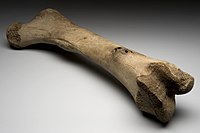
Photo from wikipedia
STUDY QUESTION Can ovarian biopsying per se and/or autotransplantation of fragmented ovarian cortical tissue activate dormant follicles and increase the number of recruitable follicles for IVF/ICSI in women with diminished… Click to show full abstract
STUDY QUESTION Can ovarian biopsying per se and/or autotransplantation of fragmented ovarian cortical tissue activate dormant follicles and increase the number of recruitable follicles for IVF/ICSI in women with diminished ovarian reserve (DOR)? SUMMARY ANSWER Ovarian biopsying followed by immediate autotransplantation of fragmented cortical tissue failed to increase the number of recruitable follicles for IVF/ICSI 10 weeks after the procedure either at the graft site or in the biopsied ovary, but 12 of the 20 women subsequently had a clinical pregnancy during the 1-year follow-up. WHAT IS KNOWN ALREADY Infertile women with DOR constitute a group of patients with poor reproductive outcome mainly due to the low number of mature oocytes available for IVF/ICSI. Recent studies have shown that in vitro activation of residual dormant follicles by both chemical treatment and tissue fragmentation has resulted in return of menstrual cycles and pregnancies in a fraction of amenorrhoeic women with premature ovarian insufficiency. STUDY DESIGN, SIZE, DURATION This is a prospective clinical cohort study including 20 women with DOR treated at the fertility clinic, Rigshospitalet, Denmark, during April 2016-December 2017. Non-pregnant patients were on average followed for 280 days (range 118-408), while women who conceived were followed until delivery. Study follow-up of non-pregnant patients ended in September 2018. PARTICIPANTS, MATERIALS, SETTING, METHODS The study included infertile women aged 30-39 years with preserved menstrual cycles, indication for IVF/ICSI and repeated serum measurements of anti-Müllerian hormone (AMH) ≤ 5 pmol/L. Patients were randomized to have four biopsies taken from either the left or the right ovary by laparoscopy followed by fragmentation of the cortical tissue to an approximate size of 1 mm3 and autotransplanted to a peritoneal pocket. The other ovary served as a control. Patients were followed weekly for 10 weeks with recording of hormone profile, antral follicle count (AFC), ovarian volume and assessment for ectopic follicle growth. After 10 weeks, an IVF/ICSI-cycle with maximal ovarian stimulation was initiated. MAIN RESULTS AND THE ROLE OF CHANCE No difference in the number of mature follicles after ovarian stimulation 10 weeks after the procedure in the biopsied versus the control ovaries was observed (1.0 vs. 0.7 follicles, P = 0.35). In only three patients, growth of four follicles was detected at the graft site 24-268 days after the procedure. From one of these follicles, a metaphase II (MII) oocyte was retrieved and fertilized, but embryonic development failed. Overall AMH levels did not change significantly after the procedure (P = 0.2). The AFC increased by 0.14 (95% CI: 0.06;0.21) per week (P < 0.005), and the biopsied ovary had on average 0.6 (95% CI: 0.3;-0.88) follicles fewer than the control ovary (P = 0.01). Serum levels of androstenedione and testosterone increased significantly by 0.63 nmol/L (95% CI: 0.21;1.04) and 0.11 nmol/L (95% CI: 0.01;0.21) 1 week after the procedure, respectively, and testosterone increased consecutively over the 10 weeks by 0.0095 nmol/L (95% CI: 0.0002;0.0188) per week (P = 0.045). In 7 of the 20 patients, there was a serum AMH elevation 5 to 8 weeks after the procedure. In this group, mean AMH increased from 2.08 pmol/L (range 1.74-2.34) to 3.94 pmol/L (range 3.66-4.29) from Weeks 1-4 to Weeks 5-8. A clinical pregnancy was obtained in 12 of the 20 (60%) patients with and without medically assisted reproduction (MAR) treatments. We report a cumulated live birth rate per started IVF/ICSI cycle of 18.4%. LIMITATIONS, REASON FOR CAUTION Limitations of the study were the number of patients included and the lack of a non-operated control group. Moreover, 9 of the 20 women had no male partner at inclusion and were treated with donor sperm, but each of these women had an average of 6.8 (range 4-9) unsuccessful MAR treatments with donor sperm prior to inclusion. WIDER IMPLICATIONS OF THE FINDINGS Although 12 out of 20 patients became pregnant during the follow-up period, the current study does not indicate that biopsying, fragmenting and autotransplanting of ovarian cortical tissue increase the number of recruitable follicles for IVF/ICSI after 10 weeks. However, a proportion of the patients may have a follicular response in Weeks 5-8 after the procedure. It could therefore be relevant to perform a future study on the possible effects of biopsying per se that includes stimulation for IVF/ICSI earlier than week 10. STUDY FUNDING/COMPETING INTEREST(S) This study is part of the ReproUnion collaborative study, co-financed by the European Union, Interreg V ÖKS. The funders had no role in the study design, data collection and interpretation, or decision to submit the work for publication. None of the authors have a conflict of interest. TRIAL REGISTRATION NUMBER NCT02792569.
Journal Title: Human reproduction
Year Published: 2019
Link to full text (if available)
Share on Social Media: Sign Up to like & get
recommendations!